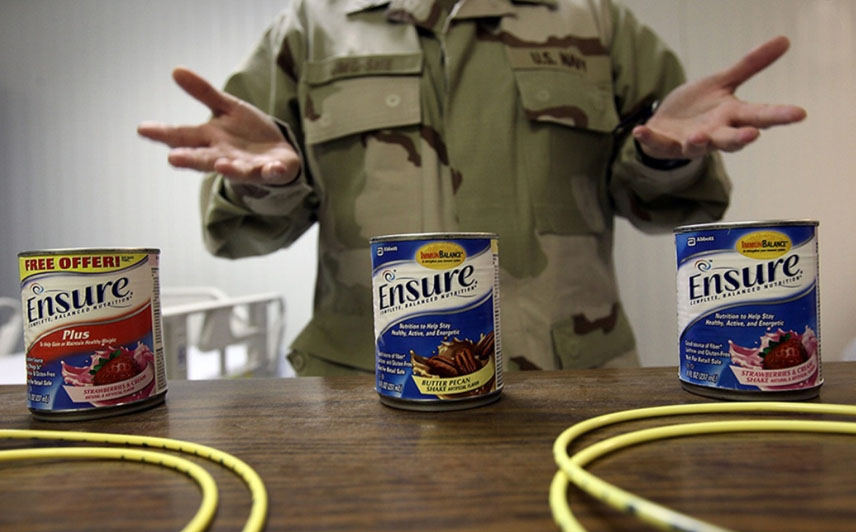
Last week the U.S. government submitted to the District Court in Washington, D.C., the most recent standard operating procedures (SOPs) for force-feeding in the Guantánamo Bay detention facility. What remains of the documents, after redactions, is a shameful exercise in doublespeak that attempts to disguise what is really happening in the prison.
The SOPs were submitted in a case brought by Abu Wa'el Dhiab, an inmate represented by Reprieve, the international human rights organization that I head. Dhiab is a 43-year-old Syrian and father of four who has been held without trial or charge in Guantánamo for 12 years. The U.S. government told Dhiab four years ago that he was cleared for release, and yet to this day he remains behind bars. In a last resort to get back to his wife and children, he, along with many others, embarked on a hunger strike. His case concerns the manner in which that entirely legitimate hunger strike has been brutally opposed by the prison authorities.
The SOPs continually offer feigned concern for the prisoners. The "sole focus" of the doctors inserting the nasal tubes "is the health and welfare of their patients"; the force-feeding is carried out according to procedures performed "in nursing homes worldwide"; assessments are to be made during the feeding to check "the emotional well-being of the detainee." One typical instruction says that after restraining and force-feeding a prisoner, "a debriefing session is important." The instruction goes on to say - in a sickening parody of customer service - that medical staffers should note "any questions and feedback provided by the detainee."
Read more closely, though, and the cracks soon begin to open. The public learns what is involved when a man is dragged from his cell, strapped to a chair with five belts and held down as a tube - perhaps dangerously lubricated with olive oil - is forced through his nose, down his throat and esophagus and into his stomach so that he can be pumped full of liquid.
Euphemisms are used throughout, but in trying to hide the truth, they become only more bizarre and frightening. Guards are told to begin the restraint process with "verbal redirection and reassurance" before moving to "limit setting," "reality orientation" and "verbal behavior contacts." If all that fails, though, the final step is far clearer: "show of force."
What do you do when a convulsing prisoner bites a feeding tube? How do you slow the fluid pumping rate if the prisoner's stomach is becoming distended?
A section of the SOPs deals with the actual feeding. No checking on emotional well-being here. Guards are told how to position themselves behind the prisoners to hold their heads in order to "reduce head and jaw motion during insertion of the EF [enteral feeding] tube"; the tube's insertion is tested by "inflating the stomach, inserting water and checking for the return of stomach fluid"; then the feeding tube is "taped to the detainee's nose and forehead" and the "feed flow" is started.
Obliquely, through the checklists and medical forms, the reader can visualize the grotesque scenes that take place daily in the feeding rooms. What do you do when a convulsing prisoner bites a feeding tube? How do you slow the fluid pumping rate if the prisoner's stomach is becoming distended? Who, precisely, in the crowd surrounding the restraint chair, is allowed to pull out the tube in emergencies?
There is no genuine care for welfare in these SOPs. Guards are even given responses to parrot in case a prisoner ever asks for help: "Detainee demands to speak to the doctor: Respond: 'I will write a note in your chart for the doctor.'"
Perhaps the most vivid image emerges from a checklist titled "Use of restraints and seclusion." On it, the guard is required to observe the prisoner and take notes using the appropriate codes to describe his behavior. The options provided place us before the cell: "Beating or kicking door," "yelling or screaming," "mumbling incoherently," "crying," "harmful to self," "requesting release."
Every day, American soldiers are being made to stand in front of metal cells, peer through peepholes and tick these boxes. Although the guidelines may appear at first to be complex and professional, these SOPs are a shameful cover-up, nothing more. The American people must see them for what they are and reject them without reserve.
Clare Algar is the executive director of Reprieve.
The views expressed in this article are the author's own and do not necessarily reflect Al Jazeera America's editorial policy.



Comment: "Beating or kicking door" check; "yelling or screaming" check; "mumbling incoherently" check; "crying" check; "harmful to self" check; "requesting release" check!
Detaining innocent men for years on end with no evidence, no charges, no convictions. To still detain them years after being 'cleared for release'. It would seem that the aim of the US in Guantánamo is to ensure that ALL of the above boxes are ticked - a sickening and inhuman game of torture bingo.
"The degree of civilization in a society can be judged by entering its prisons." --Fyodor Dostoevsky